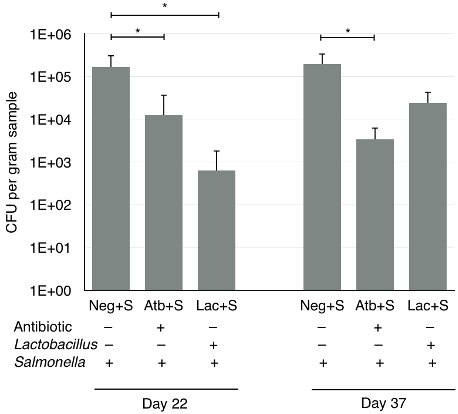VOLUME 13 (Supplement)

Philipp. Sci. Lett. 2020 13 (Supplement) 062-071
available online: July 29, 2020
*Corresponding author
Email Address: nicdao.michaelangelo@gmail.com
Date received: May 17, 2020
Date revised: July 10, 2020
Date accepted: July 23, 2020
ARTICLE
A cocktail of Lactobacillus species controls Salmonella infection and maintains animal productivity in poultry farming
University of the Philippines, Diliman, Quezon City
1101, Philippines
2Department of Sciences, College of Arts and Sciences,
Pampanga State Agricultural University, Magalang,
Pampanga 2011, Philippines
Poultry chickens are common carriers of the gut pathogen, Salmonella. They can transmit this pathogen to humans through contaminated eggs and meat. Salmonella can be controlled in poultry farms using antibiotics. But because of the unregulated use of antibiotics in poultry farming that contributes to the emergence of antibiotic resistance, alternatives to antibiotics are being sought. Therefore, this study determined whether food product isolates of Lactobacillus spp., which were previously found to inhibit Salmonella in vitro, could be exploited to control Salmonella infection in Cobb broiler chickens. Initially, the Lactobacillus spp. were tested on small animals—BALB/c mice. L. paracasei IRL14-01, L. casei IRL14-02, and L. delbrueckii subsp. bulgaricus IRL14-03 significantly reduced the recoverable CFUs of Salmonella in mice (p ≤ 0.05). Among the three, L. delbrueckii subsp. bulgaricus IRL14-03 was able to decrease the viable number of Salmonella in the gut of mice compared with untreated Salmonella-infected control mice (p ≤ 0.05). All three Lactobacillus isolates showed promising inhibitory activity against Salmonella in the mouse model, a cocktail of these isolates was tested on Cobb broiler chickens to determine its potential use as an antibiotic alternative. Daily treatment of poultry chickens with the Lactobacillus cocktail increased the recoverable CFUs of putative lactic acid bacteria (LAB) in the stool of chickens (p ≤ 0.05). However, the putative LAB count decreased significantly (p ≤ 0.01) upon induction of Salmonella infection. While there is a reduction of putative LAB numbers, the Lactobacillus cocktail can still mediate the reduction of Salmonella in chickens, especially during mid-stage farming (p ≤ 0.05). Interestingly at this period, day 22 to day 28, the Cobb broiler chickens have reached the marketable size, comparable to the untreated and antibiotic-treated chickens. Therefore, animal productivity is maintained, as chickens are ready to be sold before day 35. The Lactobacillus isolates have comparable effects with the use of sub-therapeutic doses of antibiotics in preventing Salmonella infection and maintaining animal productivity of poultry chickens. But unlike antibiotics, the Lactobacillus cocktail does not form selective pressures in the environment that promote the development of antibiotic resistance. Hence, these isolates may be explored further to determine how they can be developed as an antibiotic alternative.
© 2025 SciEnggJ
Philippine-American Academy of Science and Engineering